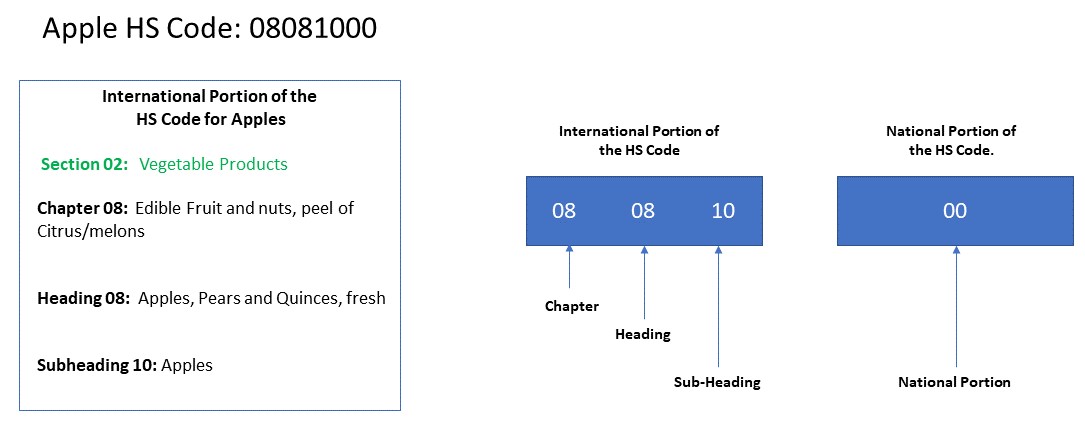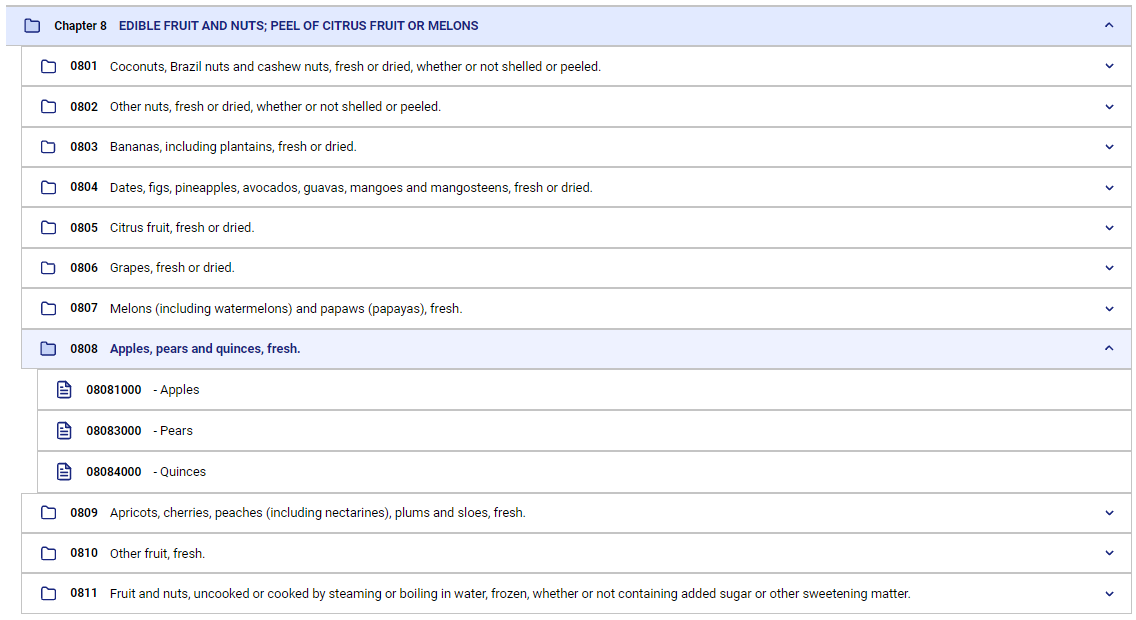What is HS Code?
What is an HS Code and Why is it Important?
All goods entering or exiting Viet Nam require a HS Code. Below is an example of the Viet Nam HS Code for Apples.

But what is a HS Code and why is it important?
The International HS Code System
The HS Code system, also known as the HS Code Harmonized System, is an internationally agreed classification system for all goods. The HS Code system is used in every country in the world to make trade safer, faster and more efficient. Traders, Customs authorities, shippers, expediters, port authorities and many others all used the internationally agreed HS Code system. This ensures everyone understands and agrees exactly what is in any shipment that crosses international borders.
Who created and maintains the Harmonized System?
The Harmonized System is organized and maintained by the World Customs Organization (WCO). The WCO membership is a world-wide organization of Customs authorities, charged with simplifying, codifying, and promoting international trade. A link to the WCO’s website is provided here - http://www.wcoomd.org/. On the website you will find a variety of tools to help you understand international trading rules, along with a full description of the Harmonized System, how it developed, how it is applied and other, related resources.
Viet Nam is a member of the WCO, and as such contributes to international discussions and decisions as to how trade should be regulated and facilitated, and how goods should be classified and measured, under the HS Code system.
How does the HS Code System Work?
The first six (6) digits of the HS Code System
The HS Code system breaks all goods of all types into: Sections, Chapters, Sub-Chapters, Headings and Sub-Headings. With each level of the system, come explanatory notes, legal definitions of goods, and a sequential breakdown of goods based upon the agreed structure. This structure and its accompanying notes and rules is known as the HS Code Nomenclature, or more commonly just the Nomenclature.
Within the Nomenclature, Sections are groups of Chapters, created to group together broad types of goods of similar type, function, composition, affect, purpose or use. In turn, Chapters group more closely related goods together, to provide yet finer detail. Each Chapter is given a two-digit code, ranging from 01 to 99, to identify the Chapter particular goods are classified in.
In our apples example, “Chapter 08 - Edible Fruit and Nuts, Peel of Citrus Fruit and Melons” contains apples. This gives us our first two HS Code digits – 08 representing the Chapter apples sit inside.
In a similar fashion, Chapters are composed of Headings, again grouping similar goods every more closely, and again identifying those goods by two digits. These Heading digits ranging from, 01 to 100, with 100 being represented by a 00. This breakdown is repeated yet again for Sub-Headings (again 01 to 00).
So, to continue our apple example…
Apples are under Chapter 08, and next we can see they fall under Heading 0808 “Apples, pears and quinces, fresh”. The 08 in the 0808 comes from the Chapter, and the next 08 is added on from the Heading itself.
Finally, under the Sub-Heading we want differentiate apples from pears and quinces. Apples have a final international HS Code of 080810 under the international HS Code system, with the 10 on the end of the Chapter and Heading digits coming from the Sub-heading specifically for apples.
Finally, if we look a bit further at Pears and Quinces as well as Apples, we can see the following HS Codes:
- 080810 – Apples
- 080830 – Pears
- 080840 – Quinces
You will notice that the coding does not start with 080801 for Apples and 080802 for Pears for example, as one might expected if we numbered straight from 01 to 00. Why? Because the Nomenclature often leaves gaps in the lower-level numbering to allow for future goods or products to be inserted. If all the one hundred numbers at the six-digit level are used up, then the actual Heading above might itself be further split up as required.
In total, the WCO HS Code system describes all goods down to six digits – Chapter, Heading and Sub-heading. These six-digit codes are internationally standardized and recognized. This gives the following structure:

So where do the last two digits in the HS Code come from? Beyond six digits, countries are free to break goods into finer detail if they so desire. Viet Nam uses 8 digits for its HS Code system, putting two extra digits on the end of the international HS Code system.
But why do countries add extra digits to their HS Codes?
Because for some, but not all goods, a government might want to collect better statistical data. The following example for Viet Nam shows the 8-digit codes for some types of motor vehicles.
Why? Because the import and export of vehicles and vehicle parts is important to Viet Nam, so the government requires better trade data than it does for apples. For consistency and ease of maintenance, most governments who choose to collect data beyond six-digits ensure that all goods codes in their Tariffs are the same length.
In the case of Vietnam, if extra digits aren’t currently required for a product, a simple 00 is added to the international six-digit code. If extra data is required later, the goods are then reordered at the lowest level based as required.
In our apple example, at the moment the Viet Nam code for apples is 08081000. In the future, if Viet Nam decided it wanted to identify and track a particular type of apple for some reason (say to protect Viet Nam’s intellectual property or to measure the export growth of a particular sub-species of apple like Braeburn or Granny Smith); then by having 8 HS Code digits available, it could recode as apples:
- 08081001 – Braeburn Apples
- 08081002 – Granny Smith Apples
- etc
And
- 08081000 – Other Apples (to cover all other apples)
As you can see, this coding would still agree with the international classification of apples at six digits, but also enable the Government of Viet Nam (GVN) to collect the additional trade data it requires.
HS Code classification can be complex. For full details please refer to the HS Code Nomenclature for Vietnam, located at this link on the Viet Nam National Trade Repository (VNTR) website. Please see the full HS 2017 Explanatory Notes here.








